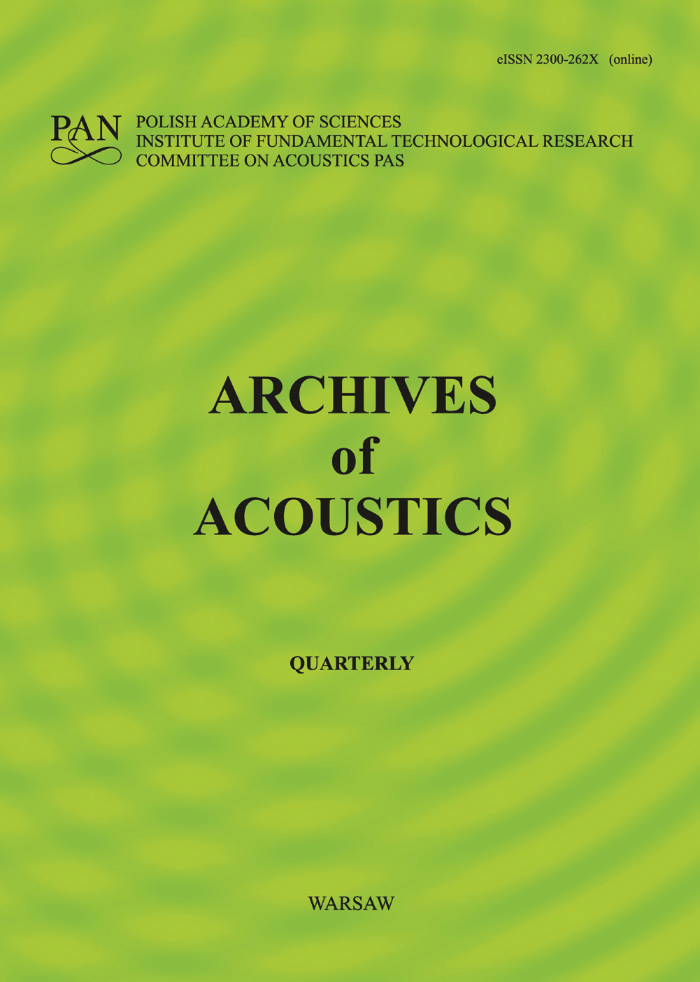Sensitivity Analysis of Acoustic Parameters in a Theatre Hall: A Case Study of the Maria Zankovetska Theatre in Lviv
Abstract
This article explores the potential for modifying acoustic parameters within a theatre hall, using the Maria Zankovetska Theatre in Lviv, as a case study. The study used sensitivity analysis to evaluate how changes in the sound absorption of specific surfaces affect selected acoustic parameters in the horseshoe-shaped theatre hall. A numerical model of the hall is developed and calibrated based on in-situ acoustic measurements to assess the sensitivity of parameters such as reverberation time (T20), early decay time (EDT), clarity (C50), and early sound strength (G80).
The analysis reveals that surfaces such as the stage tower ceiling, stage walls with curtains, audience walls, and seating have the most significant impact on the acoustic parameters. Modifying the sound absorption of these surfaces can affect T20, EDT, C50, and G80. Notably, increasing the absorption of a single surface might not significantly alter C50 and G80 values, whereas reducing the absorption of surfaces such as seating can lead to noticeable changes in these parameters. These findings provide valuable insights for future renovations and acoustic adjustments, aiming to optimize the theatre’s acoustic performance while preserving its historical character.
Keywords:
room acoustics, sensitivity analysis, sound absorption coefficient, reverberation timeReferences
- Barron M. (2009), Auditorium Acoustics and Architectural Design, 2nd ed., Spon Press.
- Beranek L.L., Hidaka T. (1998), Sound absorption in concert halls by seats, occupied and unoccupied, and by the hall’s interior surfaces, Journal of the Acoustical Society of America, 104(6): 3169–3177, https://doi.org/10.1121/1.423957
- Binek W., Pilch A., Kamisiński T. (2022), Direct application of the diffusers’ reflection patterns in geometrical acoustics simulations, Applied Acoustics, 198: 108949, https://doi.org/10.1016/j.apacoust.2022.108949
- Borgonovo E. (2008), Sensitivity analysis of model output with input constraints: A generalized rationale for local methods, Risk Analysis, 28(3): 667–680, https://doi.org/10.1111/j.1539-6924.2008.01052.x
- Borgonovo E., Plischke E. (2016), Sensitivity analysis: A review of recent advances, European Journal of Operational Research, 248(3): 869–887, https://doi.org/10.1016/J.EJOR.2015.06.032
- Hamm N.A.S., Hall J.W., Anderson M.G. (2006), Variance-based sensitivity analysis of the probability of hydrologically induced slope instability, Computers & Geosciences, 32(6): 803–817, https://doi.org/10.1016/J.CAGEO.2005.10.007
- Iooss B., Lemaˆıtre P. (2015), A review on global sensitivity analysis methods, Uncertainty Management in Simulation-Optimization of Complex Systems. Algorithms and Applications, pp. 101–122, https://doi.org/10.1007/978-1-4899-7547-8 5
- International Organization for Standardization (2009), Acoustics – Measurement of room acoustic parameters. Part 1: Performance spaces (ISO Standard No. 3382-1:2009), https://www.iso.org/standard/40979.html
- Kamisiński T. (2010), Acoustic simulation and experimental studies of theatres and concert halls, Acta Physica Polonica A, 118(1): 78–82, https://doi.org/10.12693/APhysPolA.118.78
- Kamisiński T. (2012), Correction of acoustics in historic opera theatres with the use of Schroeder diffuser, Archives of Acoustics, 37(3): 349–354, https://doi.org/10.2478/v10168-012-0044-1
- Kamisiński T., Kinasz R., Rubacha J., Flach A. (2009), Acoustic studies of selected materials for the renovation of the interior of the Lviv Opera [in Polish], [in:] Building Physics in Theory and Practice: XII Polish Scientific and Technical Conference, pp. 143–144.
- Manache G., Melching C.S. (2008), Identification of reliable regression- and correlation-based sensitivity measures for importance ranking of water-quality model parameters, Environmental Modelling & Software, 23(5): 549–562, https://doi.org/10.1016/J.ENVSOFT.2007.08.001
- Pianosi F. et al. (2016), Sensitivity analysis of environmental models: A systematic review with practical workflow, Environmental Modelling & Software, 79: 214–232, https://doi.org/10.1016/J.ENVSOFT.2016.02.008
- Pilch A. (2020), Optimization-based method for the calibration of geometrical acoustic models, Applied Acoustics, 170: 107495, https://doi.org/10.1016/j.apacoust.2020.107495
- Pilch A. (2021), Optimized diffusers for shoe-box shaped performance halls, Applied Acoustics, 178: 108019, https://doi.org/10.1016/j.apacoust.2021.108019
- Pilch A. (2024), Sensitivity testing in room acoustic modeling on changes of input parameters on the example of selected concert halls, [in:] Proceedings of the 10th Convention of the European Acoustics Association Forum Acusticum 2023, pp. 111–114, https://doi.org/10.61782/fa.2023.0955
- Prodi N., Pompoli R. (2016), Acoustics in the restoration of Italian historical opera houses: A review, Journal of Cultural Heritage, 21: 915–921, https://doi.org/10.1016/j.culher.2016.03.004
- Rubacha J. et al. (2019), Analysis of the acoustic parameters of the Maria Zankovetska Theatre in the Lviv before and after modernisation of the audience, [in:] IOP Conference Series: Materials Science and Engineering, 471: 082035, https://doi.org/10.1088/1757-899X/471/8/082035
- Rubacha J., Pilch A., Zastawnik M. (2012), Measurements of the sound absorption coefficient of auditorium seats for various geometries of the samples, Archives of Acoustics, 37(4): 483–488, https://doi.org/10.2478/v10168-012-0060-1
- Saltelli A., Annoni P. (2010), How to avoid a perfunctory sensitivity analysis, Environmental Modelling Software, 25(12): 1508–1517, https://doi.org/10.1016/J.ENVSOFT.2010.04.012
- Saltelli A., Tarantola S., Campolongo F., Ratto M. (2004), Sensitivity Analysis in Practice: A Guide to Assessing Scientific Models, Wiley.
- Shtrepi L. (2019), Investigation on the diffusive surface modeling detail in geometrical acoustics based simulations, The Journal of the Acoustical Society of America, 145(3): EL215–EL221, https://doi.org/10.1121/1.5092821
- Szeląg A., Kamisiński T., Lewińska M., Rubacha J., Pilch A. (2014), The characteristic of sound reflections from curved reflective panels, Archives of Acoustics, 39(4): 549–558, https://doi.org/10.2478/aoa-2014-0059
- Szeląg A., Rubacha J., Pilch A., Majchrzak A., Kamisiński T. (2020), Reflective panels with Schroeder diffusers – A measure to broaden the effective frequency range of sound reflection from overhead stage canopies, Applied Acoustics, 157: 107034, https://doi.org/10.1016/j.apacoust.2019.107034
- Tang Y., Reed P.,Wagener T., van Werkhoven K. (2007), Comparing sensitivity analysis methods to advance lumped watershed model identification and evaluation, Hydrology and Earth System Sciences, 11(2): 793–817, https://doi.org/10.5194/hess-11-793-2007







